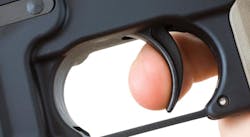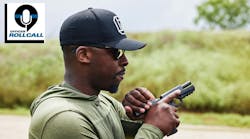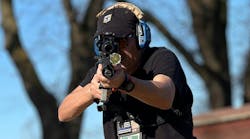I’m a month into running an in-service tactical training program. Each Monday and Wednesday I’m running officers two at a time, through a scenario based on their response to armed robbers running into an area business with shots fired from within. The shoot / don’t shoot 3-D and photo realistic “targets” turn, flop, drop, run and hide from them. Armed with marking cartridge pistols, it is their job to use sound team and individual tactics to move; clear; communicate – with each other, innocent citizens and suspects; while utilizing cover and delivering accurate fire on target when called for.
The results have been “interesting.” Some officers move, slice the pie, respond well and properly assess shoot from don’t shoot. Some others…well, let’s just say that they have not been so successful. The difference between the two?
Mindset and Physical Skills
Put simply, the officers and detectives who are successful – safely clear the rooms while minimizing their own exposure and make proper deadly force decisions have the right balance of mental edge and fundamentals of tactics and shooting.
It’s not rocket science folks but it does require work. From my observations, here’s a list of worthwhile attributes and developed skills.
- Know how to “run the gun” – the fundamentals of marksmanship must be attained through training and maintained through practice
- Control your fear – yes, even in the basement of the police training bureau officers feel the very real effects of the SNS – Sympathetic Nervous System response. This response primes you for optimum performance but must be controlled by autogenic breathing. A few deep breaths clears the mental fog of fight or flight and takes control of your body
- To get value of any training exercise you must make it real. Whether on the range in live-fire or in shoot / don’t shoot scenarios such as this to quote one of my mentors Paul Whitesell, “Every drill a bloodless battle, every battle a bloody drill”
- Keep your pistol up – searching a structure a low ready, especially rolling out from cover with the pistol held down robs you of life saving micro-seconds should there be an armed threat ready to shoot
- Abandon the “Quick Peek” – popping out and exposing your brain box to a suspect and not in a position to shoot achieves nothing. Most times you can’t see enough to make an assessment and if you peek again, you’ve given a suspect an aiming point when your melon pops out again
- “Roll-Out” from cover – in this technique which I’ll credit firearms John Farnam for instilling in me, your firearm is up and you roll only your upper body out from cover. From the suspect’s vantage point the roll-out exposes about half of your head and handgun or long-gun, versus giving away your position by leading with a foot and leg
- Quarter the room a.k.a. “slice the pie” – by breaking the room up into manageable parts or “slices of the pie” you do not overexpose yourself to bad guys in the room. Step, roll-out and repeat until you’ve cleared as much of the room as you can from the hallway or outside
- If you see an armed suspect while slicing the pie, don’t step out from cover to shoot. I’ve seen this quite a few times and it is a potentially deadly tactical failure
- Stay away from corners or walls – when slicing the pie or maneuvering, back off the wall or corner. This will allow you to have your pistol or carbine up, ready to shoot
- Modern office cubicles are not cover. Some are made of little more than reinforced cardboard. When possible, use real cover
- Understand the many ready or preparatory positions – low ready or 45 degree angle towards the floor can be used if you want the pistol out but don’t have a defined threat area or suspect; holding on the hips of a suspect allows you to see their hands; high ready or “air marshal’s ready can be used in closer confines; chest tuck with the pistol held in one hand outside the pectoral muscle, can be utilized when clearing a small room or approaching a door or suspect; position Sul is a transition position when maneuvering around partners or other officers. Each position has its place during an armed clearing operation
- Have a flashlight all the time – white lights can help you clear darkened areas or “black-holes” as low-light guru Ken Good calls them. Even in an otherwise adequately lit room a black-hole such as a credenza, closet or under a desk can present a problem
- If you have a weapon mounted light, practice with it – there have been several officers with white lights mounted to their pistols you haven’t activated the light or used it. I like weapon mounted lights (used in conjunction with handheld lights) but you have to practice and train with them
- Aviate, navigate, communicate – the time to get on the radio is after you’ve solved the problem. Too many officers have been injured or killed when they started talking to dispatch in the middle of a gunfight. To paraphrase a partner of mine, “Nobody is going to pop out of the radio when you key the mic. They are, at best, a couple of minutes away” solve the problem, then talk to dispatch and/or other units
- In real life there is movement – innocent citizens and other officers will be running toward you and/or popping up in your problem area. You cannot shoot at movement.
- Don’t just look at their hands, look at the whole person – fratricide or “blue on blue” shootings occur. Officer juiced up on fight or flight and not thinking with the upper parts of their brain, have shot at a “figure with a gun,” only to find out that it was another cop or innocent citizen. Look at the whole person
- A suspect with a gun in hand is a deadly threat, over verbalization is a form of hesitation. If you encounter a suspect with a gun, then deadly force is the response
- If you’ve fired, take a look at your firearm – numerous officers have fired on armed suspect targets, then moved towards them with a pistol in slide lock back. If you’ve shot, this is the time to slow down – assess yourself and your partner or other officers, perform any tactical or preemptive reload, and communicate with dispatch
- Carry a C.A.T., Israeli Battlefield Dressing and/or Hemostatic Agent with you – Remember E.M.S. or paramedics will not come into an unsecured “hot-zone” to save your butt. It is up to you to render self-aid and first-aid to other cops and the suspect. Remember, the courts have ruled that it is simply not enough to stand back and radio for EMS after you’ve shot a suspect, you must, if possible, render some type of first-aid. And if it’s in the car, it’s worthless
Wrap-Up
There is so much more to an armed operation or encounter than just pressing the trigger. You must think – before, during and after. You not only have a desperate need to absolutely know the legal and policy standards for the use of deadly force, you must make sure that your mindset and training have created clear neural pathways and you can control that elephant called the SNS. This type of training is invaluable. The question is, how many agencies are doing it?



